目录
? ? 前言
????????前几日,我写了一篇关于单链表的博客,想要了解的可以看一看:?数据结构之链表详解(1)
????????单链表的特征就是:单向、不带头、非循环,你们可以叫它三无链表hhh,单向就是说链表的所有节点都是只有一个指针next,它只能链接一个节点的地址或者NULL;不带头就是没有哨兵位头节点,这个之后介绍;非循环就是链表中节点之间没有环相连。其次在上篇博客里还实现了单链表的初始化、申请新节点、头插头删、尾插尾删、在某个指定位置的插入删除等功能实现。
? ? ? ? 而今天实现的双向链表与单链表完全相反,接下来就带着大家来看一看。
一.双向链表
A.双向链表的含义
双向链表:Double List Node,它的特征为:带头+双向+循环。
????????带头:就是哨兵位头节点,哨兵位头节点是用动态申请(malloc、calloc、realloc)下的一个节点,它的里面绝不存储有效数据,即它不可以作为节点进行存值,但可以存储节点的地址?,它最大的优势就是让链表的起始指针永远指向哨兵位头节点,由哨兵位头节点去插入或删除节点,这样做就不会修改链表起始指针,也就用不到二级指针;而单链表中没有哨兵头节点,所以常常要改变起始指针的指向,使用二级指针接收实参,才能去改变实参!!!
? ? ? ? 双向:单链表只有一个指针,所以一个节点只能链接一个地址;而双链表的节点中有两个指针地址,既可以链接它前面的节点地址,也可以链接它后面的节点地址,十分方便。
? ? ? ? 循环:便是双链表中头尾使用环去链接,链表的最后一个节点不会指向NULL,而是与头节点相互链接,便组成了循环。
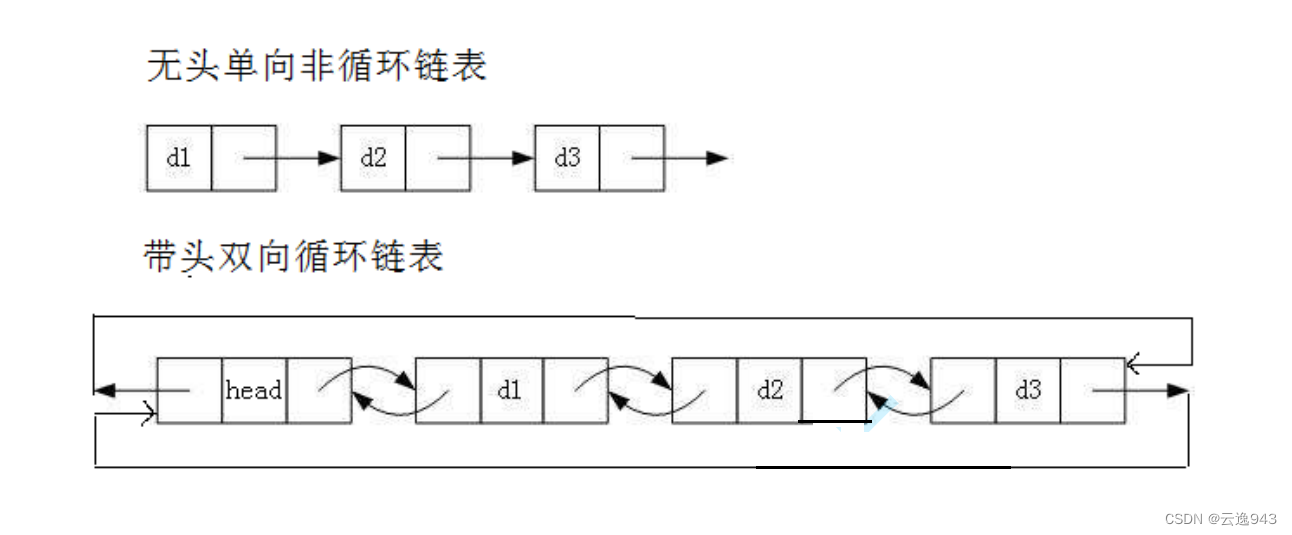
????????如上图 :双向链表的head结点就是哨兵位头节点,它用于指向第一个结点地址,而每个结点的后指针都相互指向下一个结点的前指针。
注:这个结构虽然结构复杂,但是使用代码实现以后会发现结构会带 来很多优势,实现反而简单了。
B.双向链表的实现
1.双向链表的结构
共有三部分:一个数据域,两个指针域
typedef int DLTDataType;//重命名int结构用于双向链表,使用双向链表就用这种新结构,使用普通变量还是
//使用int类型,重定义只是做一个区分而已。
typedef struct DListNode {
DLTDataType data; //数据域
struct DListNode* prev; //前指针
struct DListNode* next; //后指针
}DLNode;//重定义结构体类型名称
2.链表的初始化
初始化图解:
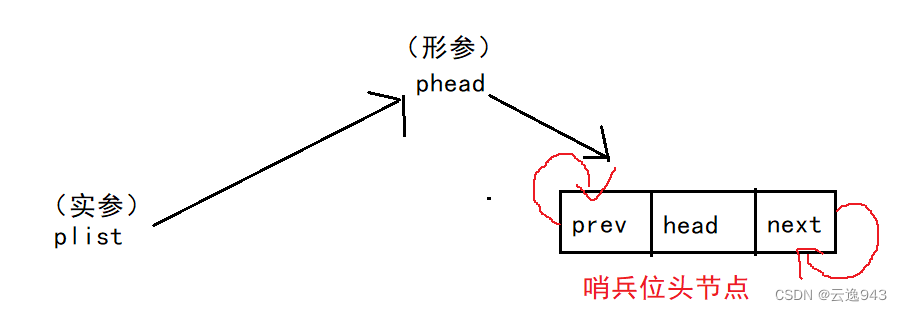
?
函数代码:
//链表初始化
void DListInit(DLNode* phead) {
DLNode* guard = (DLNode*)malloc(sizeof(DLNode));//哨兵位头节点
if (guard == NULL) {
prerror("malloc fail\n");
return -1;
}
guard->prev = guard;
guard->next = guard;
return guard;
}????????初始化便是要创建哨兵位头节点,因为哨兵位头节点不存储有效数据,且该开始两指针并不知道指向谁,所以根据双向链表循环的特性,就让该结点的两个指针自己指向自己。
?3.动态申请节点函数
函数代码:
//动态申请节点函数
DLNode* BuyDLTNode( DLTDataType x) {
DLNode* node = (DLNode*)malloc(sizeof(DLNode));
//刚申请下的堆区空间有可能开辟失败,所以要进行检查
if (node == NULL) {
perror("malloc fail\n");
return -1;
}
//开辟好后就赋值
node->data = x;
node->prev = NULL;
node->next = NULL;
return node;
}因为刚开辟下节点,还没有进行链接,所以先暂时让两指针存空。
?
?
?4.打印双向链表函数
????????打印链表就是遍历每一个节点,因为双向链表为循环,尾节点不指向NULL,头尾相连,所以需要新的限制条件——哨兵位头节点,哨兵位头节点不存储有效数据,所以遍历指针只要遇到哨兵节点就会停止,即打印完毕!
函数代码:
//打印
void DListPrint(DLNode* phead) {
assert(phead);
DLNode* cur = phead->next;
printf("guard<=>\n");
while (cur != phead) {
printf("%d<=>", cur->data);
cur = cur->next;
}
printf("\n");
}?
5.尾部插入节点
图解:
情况一:


?
????????情况一讲解:之前对于单链表的尾插实现时需要进行找尾才能插入节点(需要遍历cur!=NULL才行)?,但是双向链表的尾插不同,它不需要遍历寻找,如图1,phead作为头指针,永远指向哨兵头,而哨兵头的prev指针却是与尾部节点d3相连(头尾组成循环相连),那么尾节点就一定是哨兵头的prev指向地址,所以不需要遍历,可以轻易的找到!
?情况二: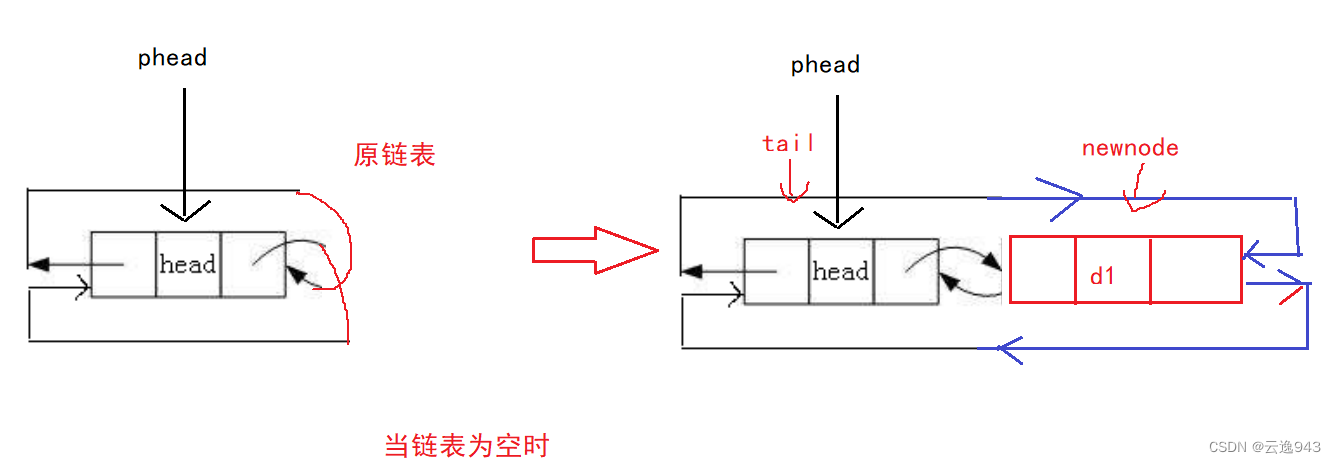
情况一与情况二原理相同。?
?
函数代码:?
//链表尾插
void DListPushBack(DLNode* phead, DLTDataType x) {
assert(phead);
DLNode* tail = phead->prev;//找到尾 尾节点指针处在哨兵位头节点的prev
DLNode* newnode = BuyDLTNode(x);//新节点
//改变顺序
tail->next = newnode;
newnode->prev = tail;
newnode->next = phead;
phead->prev = newnode;
}?测试:
void TestDlist1() {
DLNode* plist1=DListInit();
//传参时,不需要传plist1的地址,因为函数不会改变plist1的指向,因为plist1永远指向哨兵位头节点,
//使用哨兵位头节点进行改变,所以用plist传递,用一级指针接收就行
DListPushBack(plist1, 1);
DListPushBack(plist1, 2);
DListPushBack(plist1, 3);
DListPushBack(plist1, 4);
DListPrint(plist1);
}
int main() {
TestDlist1();
return 0;
}结果:
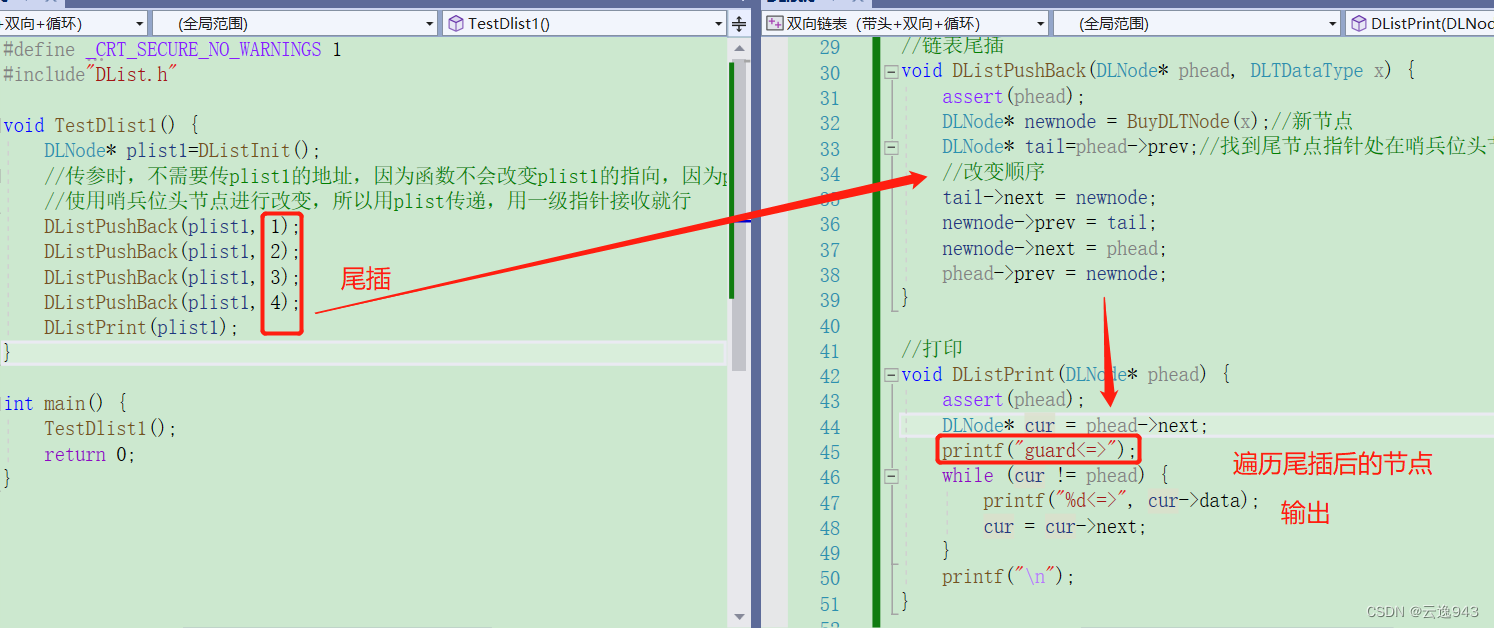
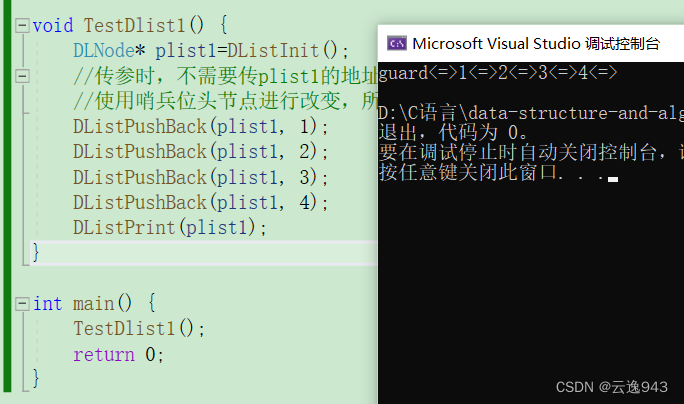
?注:phead就等价于哨兵位头节点!
?6.头插函数
图解:
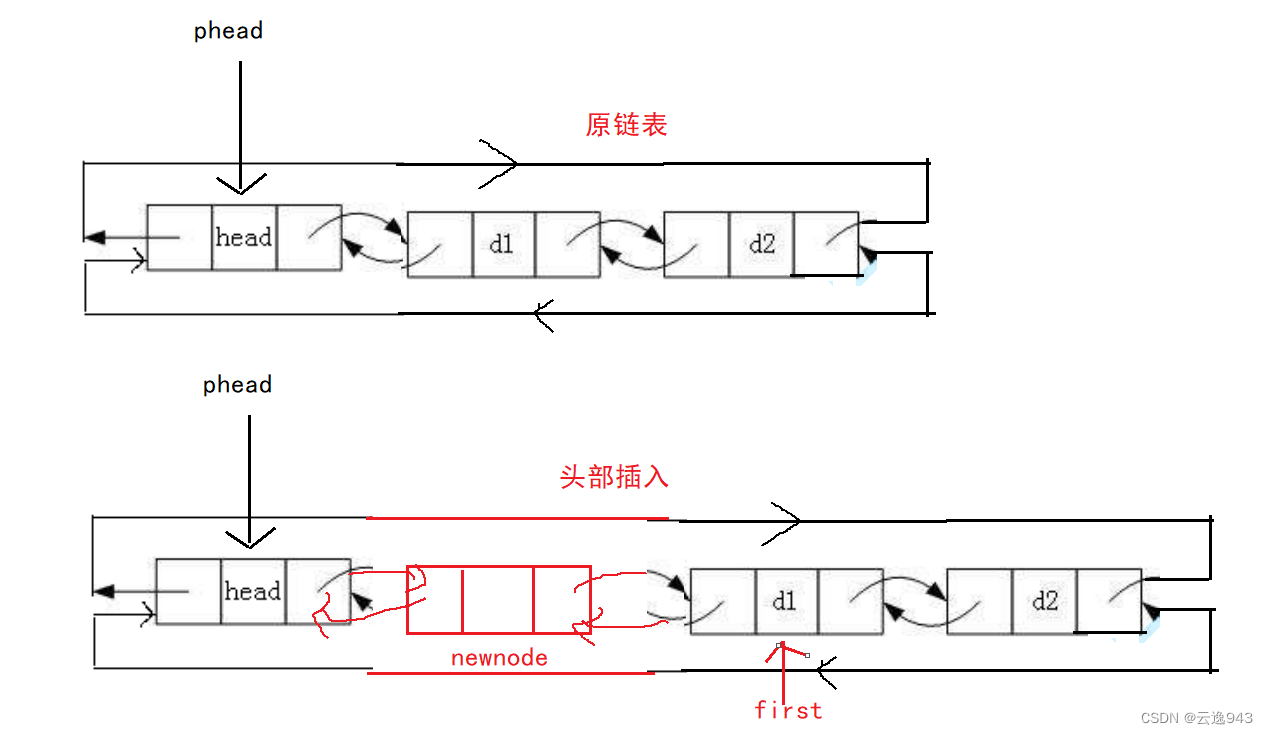
?函数代码:
//头插
void DListPushFront(DLNode* phead,DLTDataType x) {
assert(phead);
DLNode* first = phead->next;
DLNode* newnode = BuyDLTNode(x);
newnode->next = first;
newnode->prev = phead;
phead->next = newnode;
first->prev = newnode;
}测试:
 ?
?
?7.尾删函数
图解:
情况一:当链表有多个节点时
 ?
?
?
?情况二:当链表只有一个节点时?,尾删后,哨兵位头节点的两个指针就会自己指向自己
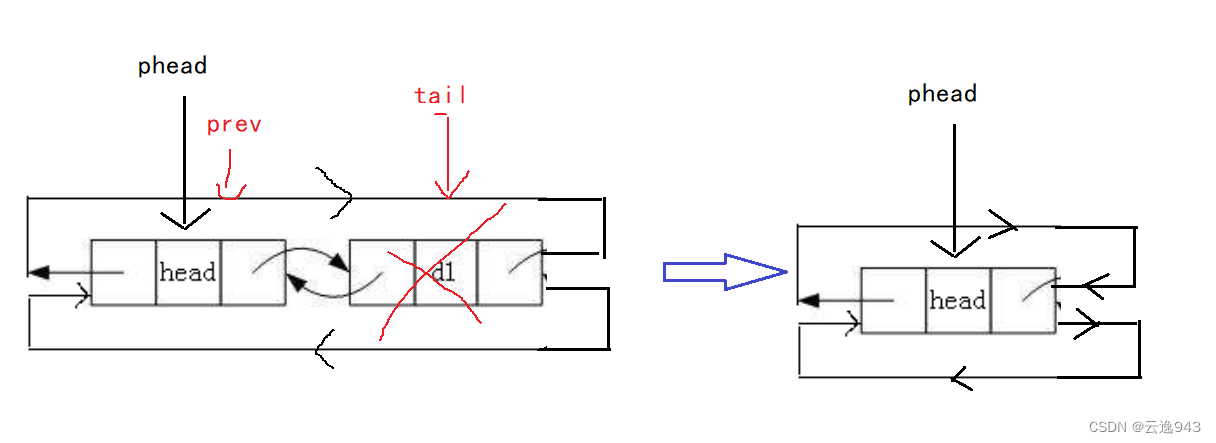
函数代码:
关于头尾部的删除,需要进行检查链表是否为空,所以,我封装了一个检查函数:
//暴力检查
bool DListEmpty(DLNode* phead) {
assert(phead);
return phead->next == phead;
}注:bool类型的返回值为true、false两种,若是phead->next==phead说明链表为空,那么assert(!DListEmpty(phead)==assert(NULL);函数就报错,且停止下面语句的执行;若是? ? ? ?phead->next !=phead说明链表不为空,那么assert(!DListEmpty(phead)这条语句就不起作用,检查通过,继续下面语句的执行。
//尾删
void DListPopBack(DLNode* phead) {
assert(phead);
//暴力检查
assert(!DListEmpty(phead));
DLNode* tail = phead->prev;
DLNode* last = tail->prev;
//改变顺序
last->next = phead;
phead->prev = last;
//释放尾节点
free(tail);
tail = NULL;
}测试:

?8.头删函数
图解:

?函数代码:
//头删
void DListPopFront(DLNode* phead) {
assert(phead);
//暴力检查
assert(!DListEmpty(phead));
DLNode* first = phead->next;
DLNode* second = first->next;
phead->next = second;
second->prev = phead;
free(first);
first = NULL;
}?
测试:

9.链表查找函数
????????查找函数可以用来查找某个节点,还可以通过对查找到的节点进行修改、对指定位置的增删功能实现。
函数代码:?
//链表查找
DLNode* DListFind(DLNode* phead, DLTDataType x) {
assert(phead);
DLNode* cur = phead->next;
//遍历查找
while (cur != phead){
if (cur->data == x) {
return cur;//找到了,返回
}
cur = cur->next;//继续往后找
}
return NULL;//找不到,返回空
}测试:?
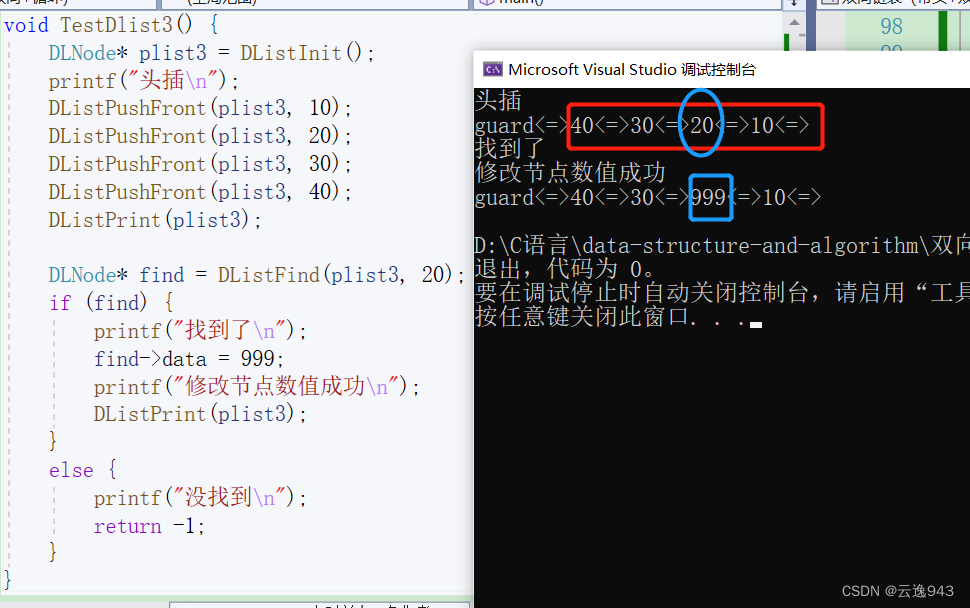
10.在链表指定的位置前插入函数?
图解:
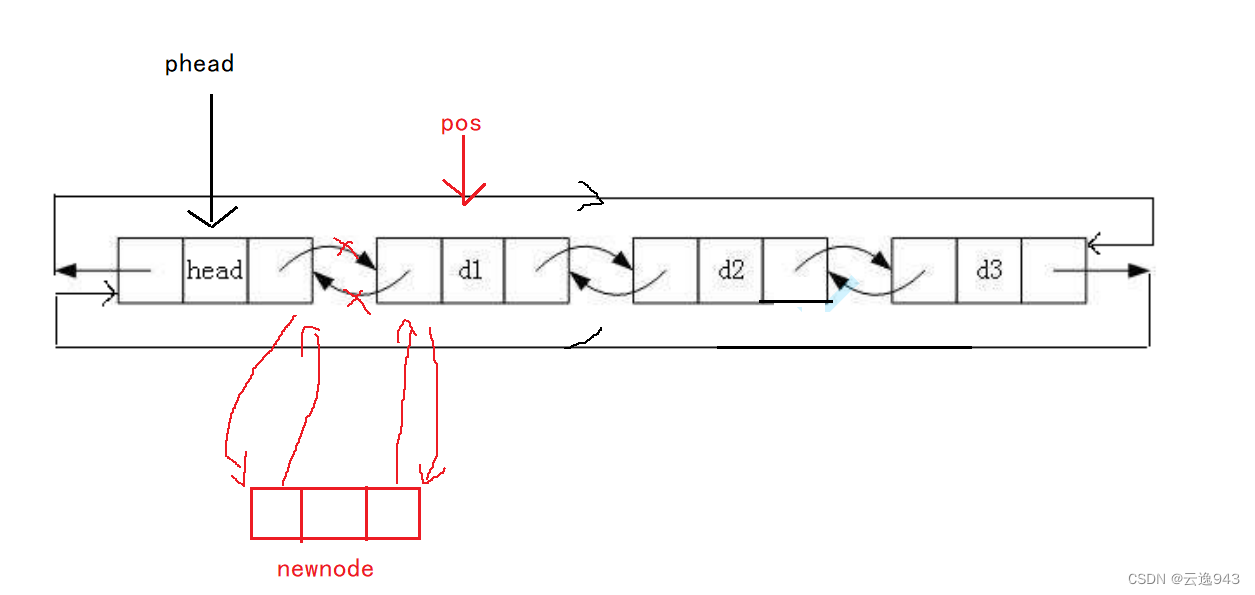
?
函数代码:
//链表在指定位置pos前插入函数
void DListInsert(DLNode* pos, DLTDataType x) {
//指定的位置不可以为空
assert(pos);
DLNode* last = pos->prev;
DLNode* newnode = BuyDLTNode(x);
last->next = newnode;
newnode->prev = last;
newnode->next = pos;
pos->prev = newnode;
}测试:
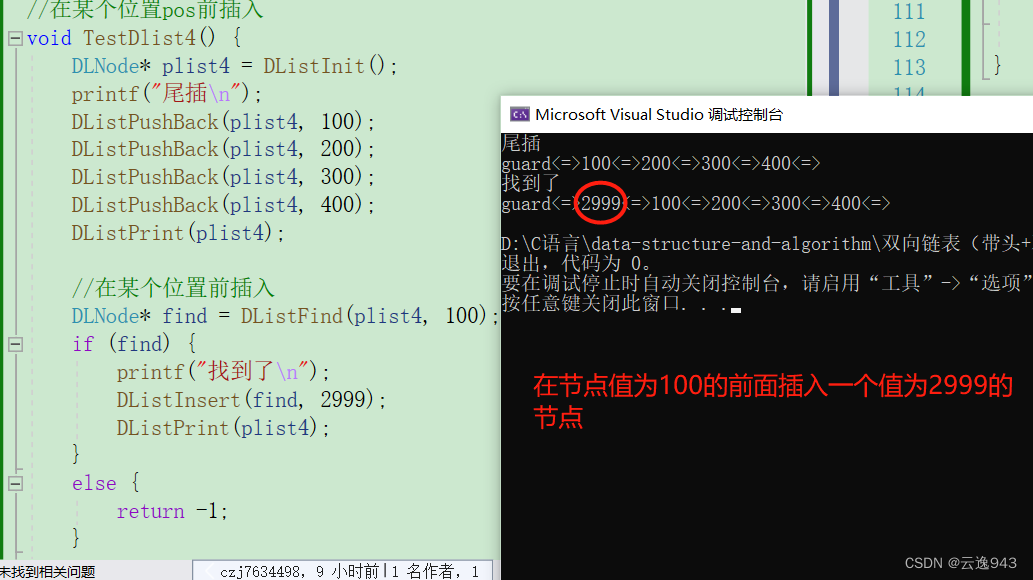
?

注:在某个位置前插入节点时,总要先找到pos的位置,然后才可以使用Insert函数!?
?
11.在链表的pos位置处删除节点
图解:
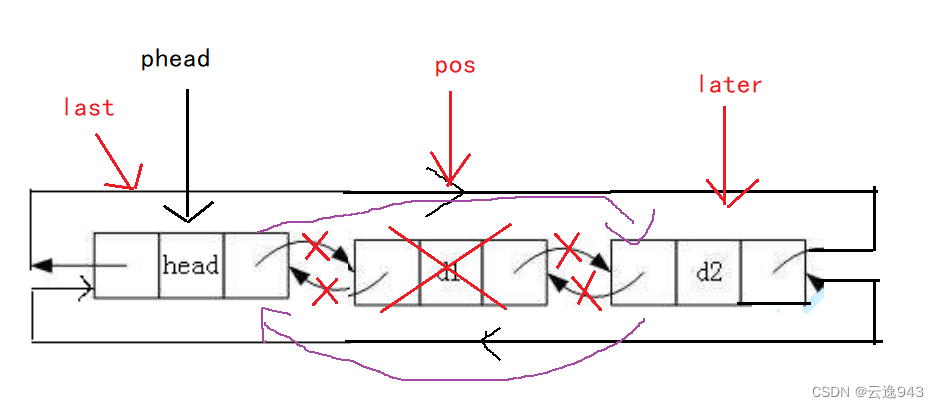
?
函数代码:
//链表在指定位置pos处删除节点
void DListErase(DLNode* pos) {
assert(pos);
DLNode* later = pos->next;
DLNode* last = pos->prev;
last->next = later;
later->prev = last;
free(pos);
pos = NULL;
}?测试:
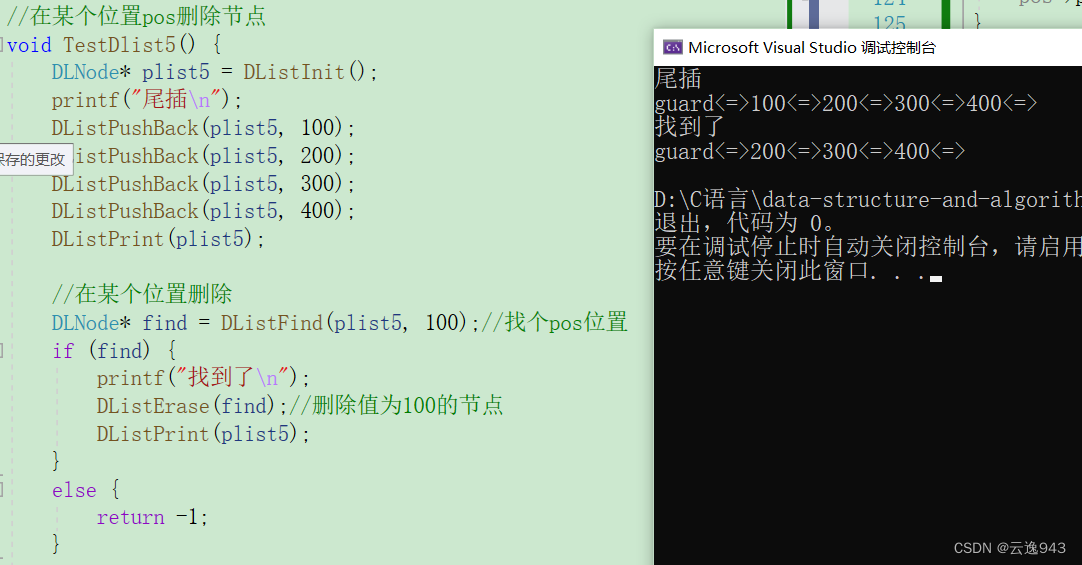
?
12.求链表的长度函数
这个函数与打印函数原理相同,都是通过指针遍历每一个节点去统计节点个数。
函数代码:
//求链表的长度函数
size_t DListSize(DLNode* phead) {
assert(phead);
size_t n = 0;
DLNode* cur = phead->next;
while (cur != phead) {
n++;
cur = cur->next;
}
return n;
}测试:
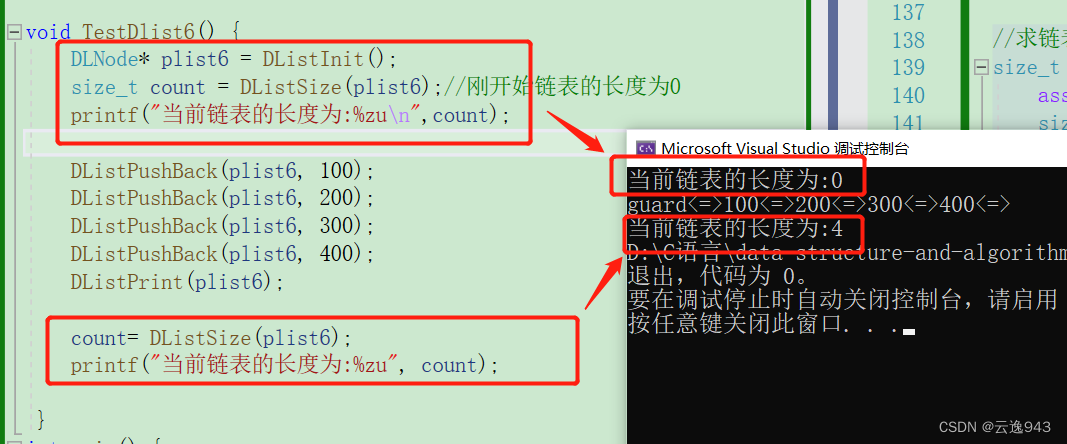
?
13.释放链表空间
函数代码:
//释放空间
void DListDestory(DLNode* phead) {
assert(phead);
DLNode* cur = phead->next;
//以遍历节点的方式,一个一个的释放
while (cur != phead) {
DLNode* later = cur->next;
free(cur);
cur = NULL;
}
//释放完后,再把哨兵位头节点也释放掉
free(phead);
phead = NULL;
}?
完整代码:
Test.c:
#define _CRT_SECURE_NO_WARNINGS 1
#include"DList.h"
//尾插
void TestDlist1() {
DLNode* plist1=DListInit();
//传参时,不需要传plist1的地址,因为函数不会改变plist1的指向,因为plist1永远指向哨兵位头节点,
//使用哨兵位头节点进行改变,所以用plist传递,用一级指针接收就行
printf("尾插\n");
DListPushBack(plist1, 1);
DListPushBack(plist1, 2);
DListPushBack(plist1, 3);
DListPushBack(plist1, 4);
DListPrint(plist1);
//尾删
printf("\n尾删\n");
printf("尾删第一次:");
DListPopBack(plist1);
DListPrint(plist1);
printf("尾删第二次:");
DListPopBack(plist1);
DListPrint(plist1);
printf("尾删第三次:");
DListPopBack(plist1);
DListPrint(plist1);
printf("尾删第四次:");
DListPopBack(plist1);
DListPrint(plist1);
}
//头插
void TestDlist2() {
DLNode* plist2 = DListInit();
printf("头插\n");
DListPushFront(plist2, 10);
DListPushFront(plist2, 20);
DListPushFront(plist2, 30);
DListPushFront(plist2, 40);
DListPrint(plist2);
//头删
printf("\n头删\n");
printf("头删第一次:");
DListPopFront(plist2);
DListPrint(plist2);
printf("头删第二次:");
DListPopFront(plist2);
DListPrint(plist2);
printf("头删第三次:");
DListPopFront(plist2);
DListPrint(plist2);
printf("头删第四次:");
DListPopFront(plist2);
DListPrint(plist2);
}
//查找,修改
void TestDlist3() {
DLNode* plist3 = DListInit();
printf("头插\n");
DListPushFront(plist3, 10);
DListPushFront(plist3, 20);
DListPushFront(plist3, 30);
DListPushFront(plist3, 40);
DListPrint(plist3);
DLNode* find = DListFind(plist3, 20);
if (find) {
printf("找到了\n");
find->data = 999;
printf("修改节点数值成功\n");
DListPrint(plist3);
}
else {
printf("没找到\n");
return -1;
}
}
//在某个位置pos前插入
void TestDlist4() {
DLNode* plist4 = DListInit();
printf("尾插\n");
DListPushBack(plist4, 100);
DListPushBack(plist4, 200);
DListPushBack(plist4, 300);
DListPushBack(plist4, 400);
DListPrint(plist4);
//在某个位置前插入
//DLNode* find = DListFind(plist4, 100);//找个pos位置
//if (find) {
// printf("找到了\n");
// DListInsert(find, 2999);
// DListPrint(plist4);
//}
//else {
// return -1;
//}
DLNode* find2 = DListFind(plist4, 400);//找个pos位置
if (find2) {
printf("找到了\n");
DListInsert(find2, 6999);
DListPrint(plist4);
}
else {
return -1;
}
}
//在某个位置pos删除节点
void TestDlist5() {
DLNode* plist5 = DListInit();
printf("尾插\n");
DListPushBack(plist5, 100);
DListPushBack(plist5, 200);
DListPushBack(plist5, 300);
DListPushBack(plist5, 400);
DListPrint(plist5);
//在某个位置删除
DLNode* find = DListFind(plist5, 100);//找个pos位置
if (find) {
printf("找到了\n");
DListErase(find);//删除值为100的节点
DListPrint(plist5);
}
else {
return -1;
}
//DLNode* find2 = DListFind(plist5, 400);//找个pos位置
//if (find2) {
// printf("找到了\n");
// DListInsert(find2, 6999);
// DListPrint(plist5);
//}
//else {
// return -1;
//}
}
void TestDlist6() {
DLNode* plist6 = DListInit();
size_t count = DListSize(plist6);//刚开始链表的长度为0
printf("当前链表的长度为:%zu\n",count);
DListPushBack(plist6, 100);
DListPushBack(plist6, 200);
DListPushBack(plist6, 300);
DListPushBack(plist6, 400);
DListPrint(plist6);
count= DListSize(plist6);
printf("当前链表的长度为:%zu", count);
}
int main() {
//TestDlist1();
//TestDlist2();
//TestDlist3();
//TestDlist4();
//TestDlist5();
TestDlist6();
return 0;
}DList.c代码:
#define _CRT_SECURE_NO_WARNINGS 1
#include"DList.h"
//链表初始化
DLNode* DListInit() {
DLNode* guard = (DLNode*)malloc(sizeof(DLNode));//哨兵位头节点
if (guard == NULL) {
perror("malloc fail\n");
return -1;
}
guard->prev = guard;
guard->next = guard;
return guard;
}
//动态申请节点函数
DLNode* BuyDLTNode( DLTDataType x) {
DLNode* node = (DLNode*)malloc(sizeof(DLNode));
if (node == NULL) {
perror("malloc fail\n");
return -1;
}
node->data = x;
node->prev = NULL;
node->next = NULL;
return node;
}
//链表尾插
void DListPushBack(DLNode* phead, DLTDataType x) {
assert(phead);
DLNode* newnode = BuyDLTNode(x);//新节点
DLNode* tail=phead->prev;//找到尾节点指针处在哨兵位头节点的prev
//改变顺序
tail->next = newnode;
newnode->prev = tail;
newnode->next = phead;
phead->prev = newnode;
}
//打印
void DListPrint(DLNode* phead) {
assert(phead);
DLNode* cur = phead->next;
printf("guard<=>");
while (cur != phead) { //遍历
printf("%d<=>", cur->data);
cur = cur->next;
}
printf("\n");
}
//头插
void DListPushFront(DLNode* phead,DLTDataType x) {
assert(phead);
//找到头节点
DLNode* first = phead->next;
DLNode* newnode = BuyDLTNode(x);
//改变顺序
newnode->next = first;
newnode->prev = phead;
phead->next = newnode;
first->prev = newnode;
}
//暴力检查
bool DListEmpty(DLNode* phead) {
assert(phead);
return phead->next == phead;
}
//尾删
void DListPopBack(DLNode* phead) {
assert(phead);
//暴力检查
assert(!DListEmpty(phead));
DLNode* tail = phead->prev;
DLNode* last = tail->prev;
//改变顺序
last->next = phead;
phead->prev = last;
//释放尾节点
free(tail);
tail = NULL;
}
//头删
void DListPopFront(DLNode* phead) {
assert(phead);
//暴力检查
assert(!DListEmpty(phead));
DLNode* first = phead->next;
DLNode* second = first->next;
phead->next = second;
second->prev = phead;
free(first);
first = NULL;
}
//链表查找
DLNode* DListFind(DLNode* phead, DLTDataType x) {
assert(phead);
DLNode* cur = phead->next;
//遍历查找
while (cur != phead){
if (cur->data == x) {
return cur;//找到了,返回
}
cur = cur->next;//继续往后找
}
return NULL;//找不到,返回空
}
//链表在指定位置pos前插入函数
void DListInsert(DLNode* pos, DLTDataType x) {
//指定的位置不可以为空
assert(pos);
DLNode* last = pos->prev;
DLNode* newnode = BuyDLTNode(x);
last->next = newnode;
newnode->prev = last;
newnode->next = pos;
pos->prev = newnode;
}
//链表在指定位置pos处删除节点
void DListErase(DLNode* pos) {
assert(pos);
DLNode* later = pos->next;
DLNode* last = pos->prev;
last->next = later;
later->prev = last;
free(pos);
pos = NULL;
}
//求链表的长度函数
size_t DListSize(DLNode* phead) {
assert(phead);
size_t n = 0;
DLNode* cur = phead->next;
while (cur != phead) {
n++;
cur = cur->next;
}
return n;
}
//释放空间
void DListDestory(DLNode* phead) {
assert(phead);
DLNode* cur = phead->next;
//以遍历节点的方式,一个一个的释放
while (cur != phead) {
DLNode* later = cur->next;
free(cur);
cur = NULL;
}
//释放完后,再把哨兵位头节点也释放掉
free(phead);
phead = NULL;
}DList.h头文件代码:
#pragma once
#include<stdio.h>
#include<stdlib.h>
#include<assert.h>
#include<stdbool.h>
typedef int DLTDataType;//重命名int结构用于双向链表,使用双向链表就用这种新结构,使用普通变量还是使用
//int类型,重定义只是做一个区分而已。
typedef struct DListNode {
DLTDataType data; //数据域
struct DListNode* prev; //前指针
struct DListNode* next; //后指针
}DLNode;//重定义结构体类型名称
//链表初始化
DLNode* DListInit();
//链表尾插
void DListPushBack(DLNode* phead, DLTDataType x);
//打印
void DListPrint(DLNode* phead);
//头插
void DListPushFront(DLNode* phead, DLTDataType x);
//尾删
void DListPopBack(DLNode* phead);
//头删
void DListPopFront(DLNode* phead);
//链表查找
DLNode* DListFind(DLNode* phead, DLTDataType x);
//链表在指定位置pos前插入函数
void DListInsert(DLNode* pos, DLTDataType x);
//链表在指定位置pos处删除节点
void DListErase(DLNode* pos);
//求链表的长度函数
size_t DListSize(DLNode* phead);
//释放空间
void DListDestory(DLNode* phead);
以上就是对双向链表的讲解和功能实现了。
